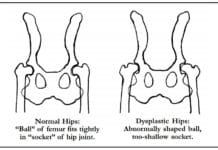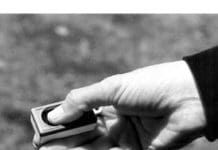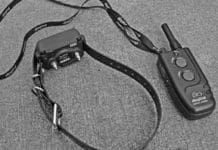Home Search
allergies/feed/rss2/aafco.org - search results
If you're not happy with the results, please do another search
Tail-Wagging Training
Training, says Massachusetts dog trainer Donna Duford, should be fun, not work. Her seminars are such upbeat, tail-wagging events that the dogs seem to be having a party. Look closer and you’ll see a serious class, with participants taking notes as Duford reviews the laws of learning and defines classical conditioning, operant conditioning, positive and negative reinforcement, positive and negative punishment, continuous and variable reinforcement schedules, and other fundamentals of behavioral training.
Much Ado About Muzzles
Let’s be clear about one thing right from the start. A muzzle won’t train your dog. It will not teach your dog to stop biting or chewing, nor will it teach him to love small children, tall men with beards, hats and umbrellas, or your veterinarian. A muzzle is a behavior management tool, properly used as a temporary measure to protect humans (or other dogs) when dogs have to be handled in situations that are too stressful for them to tolerate. A muzzle is also a flashing neon warning sign that it’s time to do some serious counter-conditioning and desensitization so the dog in question can be handled in normal situations without resorting to muzzling.
Adoptee Arrives With Baggage
establishing safe spots for them on either side of the bed; they were compelled to stay on their own cozy beds with a six-foot leash fastened to an eyebolt in the wall.
Dr. Bain also suggested that we use muzzles on both Jasmine and Sassy when they were together. She recommended basket-type muzzles
Teaching Your Puppy Critical Social Skills
If you are ever in California, you might want to make it a point to visit Carmel Beach, at the end of Ocean Avenue in Carmel Village, Monterey County. Carmel Beach is a canine utopia. Dogs are allowed, even encouraged, to run off-leash along a breathtaking Pacific Ocean backdrop. On any given day, at any given time, you’ll see Golden Retrievers racing along the sand after tennis balls, Labradors fetching sticks from the surf, Border Collies herding shorebirds, and any and all varieties of mixed-breeds and purebreds romping together in happy groups. Rarely, if ever, does a fight happen. Oh, an occasional brief scuffle maybe, as two ball-obsessed Aussies squabble over possession rights. But it’s hardly ever serious.
A Closer Look At Poop Bags
Non-dog folks turn pale at the thought. But responsible dog owners, knowing how important it is to clean up after our dogs, think nothing of reaching down and picking up a fresh, fragrant pile of Fido's feces with our hands. Oh, not our bare hands, of course, but often with nothing more than a couple of millimeters of flimsy plastic between epidermis and excrement. No big deal. Until, that is, one of those handy plastic bags breaks. Intrepid as committed poop-pickers may be, even we will blanche at the thought of . . . well, you can imagine.
Helping Dogs With Hip Dysplasia
First, I need to make it clear that there are many types of rear end lamenesses that may end up being diagnosed as hip dysplasia, but you really can't accept the diagnosis of hip dysplasia without hip x-rays. Hip dysplasia is a radiographic diagnosis, not a clinical diagnosis. That may be splitting hairs, but I see many dogs with conditions such as ruptured and improperly healed cruciate ligaments or lower back arthritis that have been diagnosed with hip dysplasia. Only radiographs can determine whether or not a dog has hip dysplasia.
Review Rebuttals
garlic
Does Your Dog Eat Poop?
Help! My dog has the most disgusting habit: eating feces! She’ll eat her own, that of other dogs, cat poop, you name it. It’s gotten to the point where I can’t take her off leash at the park; she spend her whole time trying to find some to eat, and scarfing it down greedily when she sees me running to stop her. What is UP with this?
When Your Well-Trained Dog Turns Aggressive – Act Fast!
I first met Lucy at my local monthly “My Dog Can Do That” competition in January of 1998, at the SPCA in Monterey, California. She was easy to spot – a merle Great Dane with lovely natural ears, who literally towered above the competition. Lucy was attentive, responsive, performed even the most advanced MDCDT behaviors with ease, and consistently placed in the ribbons. It surprised me, then, when a few months later I heard Lucy had started threatening humans, and her aggression was escalating. This was not appropriate behavior for any dog, but particularly disturbing in one of Lucy’s size, with her potential for causing serious harm.
Getting in Touch
Recently, I attended the annual conference for the Association of Pet Dog Trainers. Our lead writer on training, Pat Miller, has been an active member of the Association for some time, and the founder of the organization, Dr. Ian Dunbar, has been a generous contributor to Whole Dog Journal. Both Pat and Ian have encouraged me to attend the conference; they said it would be right up Whole Dog Journal’s alley.
Pharmaceuticals for Dogs: There Is No Magic Pill
Pet pills are big business, raking in an estimated $3 billion last year and growing by 20 percent each year. Pharmaceutical companies have found they can modify human drugs for pets without much additional research expense. The Food and Drug Administration (FDA) has approved 15 new behavior-altering drugs for veterinary use in the last year and a half. The two new canine drugs receiving the biggest ad blitz and the most mainstream media coverage, Clomicalm and Anipryl, both were adapted from human drugs.
Electronic-Collars – Opinions Often Vary
Because we feel deeply that dog training should be pleasurable and effective, and because we have personally witnessed innumerable successful demonstrations of completely pain- and fear-free training, we have taken the position that training tools and methods that inflict pain are inferior (a strong word, we know) to those that do not.










